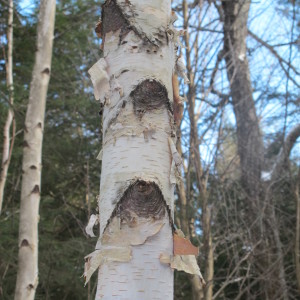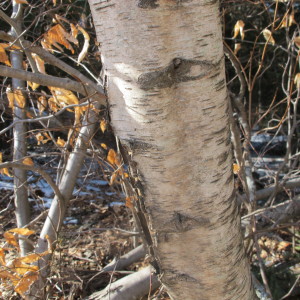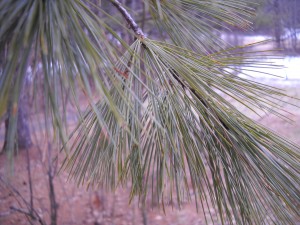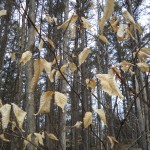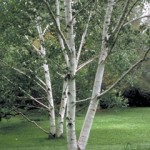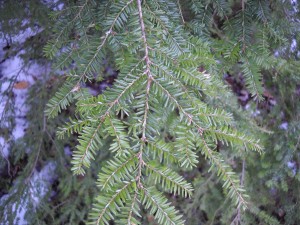Tree Identification
Winter is a slow time for me – there is no weeding or mowing or transplanting to do – so I have time to cross country ski or walk almost every day. I love observing the trees and native shrubs of the forest, and try to know the name of everything I see. Trees without leaves are a bit of a challenge to most of us, but by now I should know almost everything I see, either by tree shape, bark or buds. If you don’t know the woody plants you see in winter, now is a good time to learn them.
I own a number of books that are sold as tree identification books, though most of them try to cover every tree in North America, and can be difficult to use. Last year I got one I really like and sometimes put it in my pack, just in case I see something out of the ordinary. It’s called Forest Trees of Vermont by Trevor Evans. It has detailed information about 82 trees native to Vermont or that have been introduced and are common in the state. Each species has 3 to 6 photos of the leaves, bark, buds, flowers, nuts and sometimes the entire tree, along with descriptions of important characteristics.
There are six species poplars, for example, that grow in Vermont (and presumably throughout New England), but only 4 are native. I know just 2 of the native poplars, the big-toothed poplar (Populus grandidentata) and the quaking aspen (P. tremuloides), and one non-native species, the Lombady poplar (P. nigra) So much for knowing all the trees of the forest. For each genus (a scientific grouping a closely-related plants), there is a chart that summarizes the differences and similarities of each species for their bark, leaves and buds (which are key for winter identification).
An interesting distinction for poplars is the difference in taste of the bark. I’d never read any reference to taste before as a distinguishing characteristic. Quaking aspen has ”very bitter” tasting bark, according to the book, while bigtooth aspen does not. That’s a very useful and easy distinction – from a tree farmer who clearly know his trees. Taste is not a distinguishing characteristic for most groups and is not mentioned, but the odor of twigs is used for cherries and plums. Again, very useful.
The book also has 2 dichotomous keys: one for summer identification, one for winter. In high school biology class I learned to use keys, and find them useful. A key has pairs of observable characteristics. So, for example, a useful distinction is whether a tree has needle-like leaves, or broad leaves. In the first group, all but the tamarack are evergreen. By dividing all trees into 2 those categories, the pool of trees is considerably reduced. In the first group you have pines, cedars, spruce, firs, hemlock and tamarack. Then a second pair of characteristics is used to divide each group into a smaller group, and so on until you find your tree.
Even though, as a well known geezer, I do not have a cell phone, I recognize the utility of including QR codes in the book. For you other geezers and geezerettes, a QR code is a little square with dots that you show your cell phone and, though the wonder of the internet, connects you to a database. In this case there are one or two codes per tree: one taking you to the U.S Department of Agriculture’s NRCS site, another to the Forestry Service site. There is a huge amount of information available there.
Long ago I learned another good distinction: whether leaves and twigs sit opposite each other, or staggered on a branch. There is a mnemonic to help with this: MADCap Horse. That stands for Maple, Ash, Dogwood, members of the group Caprifoliaceae (a group including honeysuckles, viburnums, elderberries and some other shrubs) and horse chestnut – those all have opposite branching. Eeverything else has alternate branching (with minor exceptions, of course).
I should note that the opposite branching distinction is not infallible. For example, a mature sugar maple has many twigs that do not appear to be opposite another. That is because one has fallen off. Look to the top of the tree, where younger twigs are present and you will see opposite pairing.
In winter bark is useful to me for identifying trees. Everyone can probably identify a birch by its whitish bark. But is it a white or paper birch (Betula papyrifera) or a gray birch (B. populifolia)? According to the charts in Forest Trees of Vermont, both have chalky or grayish white bark but gray birch’s bark is “dirty looking”. And paper birch bark separates into “thin horizontal papery layers”, while the gray birch’s bark does not. That should do it. Yellow birch also has papery layers, but the bark is “silvery gray or light yellow”. The book also notes that yellow birch gives off a “wintergreen odor when young branches are scraped”.
Although this book was aimed at Vermont readers, I think it would be useful anywhere in New England. So go for a walk with it or the tree book of your choice, and see what you can identify.
Henry is the author or 4 gardening books. His website is www.Gardening-Guy.com. He lives in Cornish Flat, NH.
Identifying Trees in Winter
Before we launch into this week’s article…
Gardening Classes with Henry
Lebanon College: Gardening: A Practical Workshop. Garden writer Henry Homeyer will teach you the basics of organic vegetable and flower gardening. From garden design to seed-starting , planting, watering, weeding, mulching, and harvesting, this course will give each student practical knowledge of gardening. Tuesday nights from 6:30-8:30 for 5 weeks, April 3-May 2.Contact Lebanon College to reserve a spot for this5-part workshop www.lebanoncollege.edu or call 603-448-2445.
AVA Gallery, Lebanon. Henry will teach 3 classes at AVA Gallery this spring. You may sign up for one or all of these workshops:
Sculpting the Living Landscape: Starting Flowers from Seed
April 9; Monday, 6:30–8:30pm; One 2-hour class
Sculpting the Living Landscape: Perfect Perennials for the Upper Valley Garden
April 23; Monday, 6:30–8:30pm; One 2-hour class
Sculpting the Living Landscape: Organic Techniques for Enriching Soil and Managing Pests
May 7; Monday, 6:30–8:30pm; One 2-hour class
For more information go to www.avagallery.org or call 603-448-3117.
Identifying Trees in Winter
Most of us enjoying knowing the names of our acquaintances – including trees. It’s tougher to identify trees in winter because most have no leaves, which is how we generally recognize trees. But by observing overall shape, bark, branching patterns, buds and the presence or absence of leaves, you should be able to pick out several common trees quite easily.
The trees discussed here include 5 that keep all or some of their leaves; the rest lose all their leaves. The first group includes white pine, Canadian hemlock and spruce, all of which have green needles – their form of leaves. Oaks and beeches are broad-leafed trees that hold all or some of their leaves, though the leaves are dead and brown. Young trees hold more of the dead leaves than more mature ones.
White pine (Pinus strobus) has clusters of 5 soft needles, each about 3 inches long. Branches grow in whorls off the trunk; each year the tree grows just one new set of branches, so you can see how fast they grow by observing the distance between whorls on the main trunk. From a distance you can see clumps of needles pointing up near the top of the tree.
Canadian hemlock (Tsuga canadensis) has short, flat needles that feel soft to the touch and that have a white line on the underneath side of each. It is one of the few trees in the woods that can grow in deep shade – as well as full sun.
There are several kinds of spruce (Picea spp.), but all share this characteristic, which will separate them from hemlock trees: turn over a branch and observe the color of the leaves. If the needles on the top side and the bottom of the bough are the same color, it is a spruce. Spruce needles are pointy and sharp. Spruce hold more snow on their branches than other evergreens, too, often leaving little snow beneath the tree.
American beech (Fagus grandifolia) is most easily identified by its smooth gray bark; some older trees have bark that is scarred by a fungus. Their buds are up to an inch long with sharp pointy ends; they are shaped a bit like little cigars. Young beech trees hold lots of leaves but the older ones tend to lose most. Leaves are 2-5 inches long, oval, and have serrated edges.
Oaks ( Quercus spp.) also hold at least a few leaves. The leaves are lobed, often ending in a sharp point. There are a few oaks that have different shaped leaves, but you probably won’t come across one. Acorns are a dead giveaway, too, though most acorns have fallen by now.
Buds and small (side) branches are either opposite each other on a branch or they alternate – one here, one
farther along on the other side. Only 3 common trees have opposite branching: the maples (many species), ash (4 species), and horse chestnut. There are several kinds of shrubs that have opposite branching, including viburnums, most dogwoods, lilacs and honeysuckles. Don’t be deceived by the fact that often twigs are broken off, so that the branching pattern may not appear at first glance to be opposite.
Of the many kinds of maples (Acer spp.), sugar and red maples are common in most woods. At the end of each branch you will see 3 buds: a terminal bud and a bud on each side of it. The buds are sharply pointed on sugar maples, less so on red maples. Red maple buds get redder as the winter progresses. Get to know a few big old sugar maples during sugaring season, and you will soon recognize the color of bark and the overall shape. Red maples tend to have branches that spread less than sugar maples, and they can live in wet places (but sugar maples rarely do).
White ash (Fraxinus americanus) also has opposite buds, but they are much more rounded than those on maples. The key characteristic for me is the bark, which is furrowed into diamond shaped areas on mature trees. You will also see that small branches on an ash are also much less delicate than those on a maple. Looking up at branches, you will see that they have lots of lumps and bumps near their tips.
White or paper birch (Betula papyrifera) is one of the best known of our native trees: it has bright, white bark that tends to peel as the tree gets bigger. Other birches include gray and yellow birches. The former has dirty gray bark; the latter has finely peeling silvery or golden bark. All have horizontal marks on the bark called lenticels. Lenticels allow air into the inner growing layer of the tree. Their twigs are fine, and may have catkins (narrow pollen-producing structures 2 inches long or so) towards the top of the tree.
One of our most common trees is the poplar (Populus deltoides). Poplars are fast growing, short-lived trees that jump up anywhere, even in poor soil along roadsides. They tolerate wet or dry locations and are immune to road salt. I recognize them from the color of the bark – it is greenish to putty-colored, particularly up high. It is often an irregular-shaped tree that is considerably taller than wide.
So clip this article and take a walk in the woods. See what you can identify. And bring along a tree I.D. book to help. I like A Guide to Nature in Winter by Donald Stokes, as it has information about everything you can see outdoors in winter, not just the trees.
Henry is the author of four books and writes a self-syndicated weekly column for 12 newspapers throughout New England. You can contact Henry by e-mail at henry.homeyer@comcast.net.



